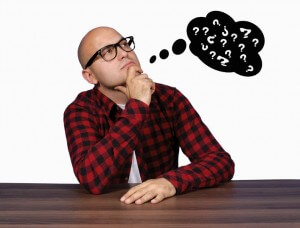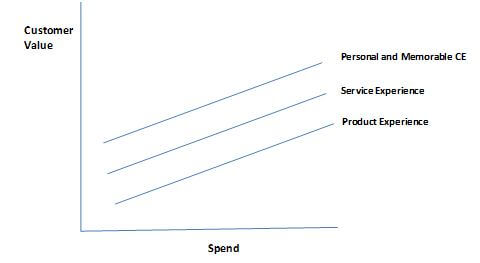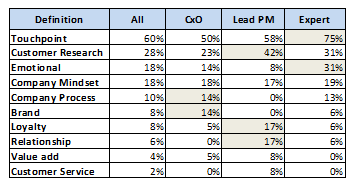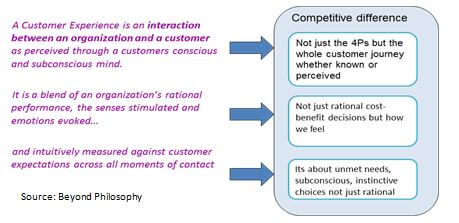Abstract
Customer Experience Management (CEM) has a confusing profile with up to 14 different definitions logged by analyst firm Gartner. Faced with such confusion CEM is now in crisis with software vendors using the term ‘as they see fit’ to sell CRM services and marketing and customer service departments seeing it as sexy rebadge for the same activity they have always performed.
This has led to an ongoing ‘definition war’ between ‘pure play’ CEM advocates and new entrants that threatens to undermine the very validity of the term. This is a dangerous situation to be in as the historical evidence suggests that any loss of validity will inevitably lead to the terms demise as it is seen more and more as a meaningless buzzword.
Therefore and in order to bring order to the market, the following paper takes an ‘ontological’ approach. Reviewing the origins of the term in the HBR article ‘Welcome to the Experience Economy’, uncovering what the term CEM refers to from these origins and compares this to how the market applies the term.
The paper concludes that the market has rejected certain elements of this paper in favour of a more holistic definition, built around the extraction of value from across the customer journey.
Introduction
A cut in price is an experience
A new product innovation is an experience
Your nice new promotional literature is an experience
…….And a staged one at that….
So what is Customer Experience Management (CEM)? Never mind how we use the word experience in our everyday language, in the context of CEM, what does the word ‘Experience’ mean; what is, to use a technical term, it’s ontology?
The key source for any definition is the HBR paper Welcome to the Experience Economy. Here Pine and Gilmore state:
‘As goods and services become commoditized, the customer experiences that companies create will matter most.’
This means that for us to understand CEM, we must understand how CEM differs from the ‘experiences’ goods and services themselves create.
So what is this unique difference? Let’s look at some more direct comments from Pine and Gilmore:
Statement A: ‘To appreciate the difference between services and experiences, recall the episode of the old television show Taxi in which Iggy, a usually atrocious (but fun loving) cab driver, decided to become the best taxi driver in the world. He served sandwiches and drinks, conducted tours of the city, and even sang Frank Sinatra tunes. By engaging passengers in a way that turned an ordinary cab ride into a memorable event, Iggy created something else entirely – a distinct economic offering. The experience of riding in his cab was more valuable to his customers than the service of being transported by the cab and in the TV show, at least, Iggy’s customers happily responded by giving bigger tips’
Statement B: An experience occurs when a company intentionally uses services as the stage, and goods as the props, to engage individual customers in a way that creates a memorable event.’
Statement C: ‘Experiences are inherently personal, existing only in the mind of an individual who has been engaged on an emotional, physical, intellectual or even spiritual level’
Statement D: ‘But experiences are not exclusively about entertainment, companies stage an experience whenever they engage customers in a personal, memorable way.’
From these statements we conclude that for Pine and Gilmore:
Point 1: Experience is about the ‘personal and the memorable’ not about experience as in ‘everything I experience’, a typical layman understanding of the term. Hence if you do not create ‘personal and memorable’ then you are not doing Customer Experience Management.
Point 2: The ‘personal and memorable’ nature of things must be value generating over and above any service or product offering which is bound by the delivery of the core aspects customers seek (such as getting from point A to point B in a taxi). CEM must be a distinct economic offering.
The first point is pretty clear, only personal and memorable experiences count: although we might argue on what exactly ‘personal and memorable’ means to the customer. But the second point is more problematic.
Experience as a ‘distinct economic offer
Figure 1 outlines the key concept, that CEM personal and memorable experiences create a differential demand. A key driver to this separation of demand curves is of course the economics of commoditization.
Figure 1: Customer Experience Management must form a distinct economic offering
To illustrate, let’s take the market for groceries. Originally, it was a question of product availability and quality that drove demand. There was a service attached to it (groceries were bought in a shop) but that was a secondary feature. This formed the ‘Product Experience’ demand line. Customer Value and increasing spend were correlated.
However, as groceries became commoditized, service came to the fore as the key differentiator. Hence, ‘I’ went to shop A over B because ‘I’ trusted them more, while the groceries between providers were much the same. In this case, the demand line was formed by the ‘Service Experience’ line. This is at a higher level than product as for the same spend there was an incremental increase in value to the customer. To be clear service had always been there, after all even the most basic product had to be delivered, but now it became accentuated and differential.
Of course, with service commoditization, it is now hypothesized that personal and memorable experiences come to the fore: so I may go to a Stew Leonard’s grocery store to see the beautiful displays and animatronics. This is shown by the higher ‘Personal and Memorable CE’ line. Again, ‘Personal and memorable’ has always been there within the product or service sale; it is just now becoming accentuated and differential ‘from the product or service’.
When CEM becomes a separate demand
On the face of it this approach seems to make sense. But, where is that point of separation? When does personal and memorable Experience become something different from just personal and memorable service or product experience?
Sure when ‘service’ is described as a simple thing, only focused on, in the case of the taxi ride, getting from point A to point B it is easy to describe the difference. But, this feels far too simplistic a definition when in reality there are so many component parts of service. For instance, what about customer comfort and care or the friendliness of the taxi driver are these not also components of the generic word ‘service’.
Pine and Gilmore themselves admit this point, stating that previously economists had assumed this formed a ‘part of service’. Other standard ratings of service quality such as SERVQUAL also emphasis the complexity of the general word ‘service’: a complexity that includes elements beyond the transactional such as empathy.
To find this point then we must use some method to describe when ‘personal and memorable’ in of itself becomes the ‘distinct economic offering’ something ‘customers happily’ respond to ‘by giving bigger tips’.
To help us understand this difference lets now apply something called the ‘Customer Talk Test’. The rule is, if a customer would demand the ‘product or service’ experience first then it is not CEM, if they say it second it is CEM. Here is an example:
In the 1960’s McDonalds introduced new drive-in restaurants. Customers would come far and wide just to see the drive-ins. They would say:
First: ‘Wow come and see these drive-ins’
Second: ‘Oh! And we can get a burger’
Hence, it is CEM.
Of course there is a temporal dimension to CEM, which means that the drive-ins after a few years ceases to be an attraction and start to become part of the service ‘personal and memorable experience’. In the 1970s it becomes:
First: ‘We can get a burger at McDonalds’
Second: ‘Oh! And we can use their drive-in’s’
Hence, it is not CEM.
So now applying this to Customer Experience Management we can see that there 5 key conditions where ‘personal and memorable’ experiences are not CEM. These are:
Condition 1: If an experience just adds to service or product based value, it is not CEM as it does not represent a ‘distinct economic offer’
This is a little tricky as products and services change all the time but it feels disingenuous for every, say, product innovation to be labelled CEM. To give an example, occasion based segmentation has been with us since the 1960s. So when beer is sold in kegs for your party, that is not a new economic offer built around ‘personal and memorable CEM’, it is a new ‘personal and memorable product’ offer built around the service event. For it to be CEM, and occupy a different economic space, the ‘personal and memorable’ nature of the Experience has to drive customer demand.
Customer Talk Test which makes it CEM:
First: ‘I want one of those wacky looking beer kegs, they look neat’ (no mention of the core party use)
Second: ‘Oh! And I can use them for the party.’
Customer Talk Test which does not make it CEM:
First: ‘Those beer kegs would be great for my party’
Second: ‘Oh! And they look pretty neat as well.’
The implications of this are that in the Pine and Gilmore BA example, offering a more comfortable flight is only CEM ( ‘a distinct economic offer’ from service and product) rather than occasion-based segmentation (an added value product and service offer) if ‘in execution’ customers demand the ‘way’ comfort is executed rather than the offer.
It is CEM if customers say:
First: ‘I want to go BA to experience those great old style chairs.’
Second: ‘Oh! And I wouldn’t mind making sure the flight is comfortable (part of the original service value).’
Of course another example of where an experience is not separated from the product or service is when it is associated with it. So a nice looking garden centre, if it does not change the demand, is not Customer Experience.
For it to be CEM, customers must say:
First: ‘I go there because of the look of the gardens.’
Second: ‘Oh! And I can also get some plants’
It is not CEM if customers say:
First: ‘I go there to get some plants.’
Second: ‘Oh! And it looks nice as well.’
Condition 2: If ‘personal and memorable’ experience is already part of a product or service, it is not CEM as it does not represent a ‘distinct economic offer’.
There does seem to be an inherent contradiction if what is on offer already sells ‘personal and memorable’ experience. In this situation, how can it then be considered a new economic offering? Disney, for instance, sells inherently ‘personal and memorable service experiences’ and has done throughout most of the 20th century.
Likewise in product innovation (or goods innovation), CEM cannot start claiming credit for existing ‘personal and memorable’ experiences that are part and parcel of the product sold. Faberge, for instance, sells ‘personal and memorable products’.
It is true that their starting points are different, but personal and memorable is inherent to their goods and service utility, it is not separate from it. For it to formulate a separate demand curve the customer talk would have to be as follows:
Disney
First: ‘I want to go to Disneyland to experience their baked cookies they give out at the door’
Second: ‘Oh! And I want to visit the theme park and experience the rides and atmosphere.’
Faberge
First: ‘I want to go to that Faberge shop because they have a great museum’
Second: ‘Oh! And I want to buy one of those luxurious eggs.’
You can’t have it both ways; claim products and services are commoditised and then claim any product or service innovation as an example of CEM.
After all, it could be claimed that all innovation in product or service is about becoming more personal and memorable. Diet Coke, VW, Fast Food, TV, iPhone; all could claim they got closer to the consumer through product and service innovation in the ‘personal and memorable’: which just goes to show that products and services frequently are not commoditised. Commoditisation is perhaps not the end of marketing history but just a process towards more innovation.
Condition 3: If an experience is part of a stable product or service environment, it is not CEM as it does not represent a ‘distinct economic offer’.
CEM is not relevant to every ’ordinary’ situation. For instance, if ‘I’ want a cheap pen at a local convenience store then that’s what ‘I’ want, period. The pen is a commodity, although the channels of distribution controlled by, for instance, the co-op may still be open to ‘personal and memorable’ B2B experiences.
Condition 4: If an experience gets redefined over time to be part of the product or service in question, it is not CEM as it does not represent a ‘distinct economic offer’.
What if ‘personal and memorable’ becomes part of tomorrow’s standard ‘good’ or ‘service’? A themed shopping mall is no longer exciting but becomes de-rigour for all malls and customers soon go back to saying, ‘I want that good, or service, oh! And the Mall looks nice.’
It seems there is therefore an important temporal dimension to Experience, in other words it can be commoditised itself! Maintaining and updating Experience value through new innovation is as true as it is for goods and services. Of course using CE to change what it means to shop (visiting an expensive Mall) is an important competitive approach, but that still doesn’t change the fact that CE ultimately moves back into product or service, if with a different competitive set!
This raises a key challenge to business: how to keep CE as a distinct economic offering for the long run. One way to look at this is in terms of replicability; if the CE advantage lies in a big Wow! Or unique employee skillsets that you can control, then it is more likely to remain differential.
Having looked at what Customer Experience is not, we finish with a definition of what it is:
Condition 5: If an experience offers a new demand different from the service and product in question (even if this is only a short-run effect) it is CEM.
A key passage in the definition of ‘distinct economic offering’ is the use of the term ‘created something else entirely.’ This means that the purchase is around a changed demand i.e., for that something else! This is more explicitly made in the point ‘The experience of riding in his cab was more valuable to his customers than the service of being transported by the cab….. Customers happily responded by giving bigger tips.’
So, CEM is about creating a demand for a ‘personal and memorable Experience’ that is distinct from the product or service sold. Yet how do you separate out ‘personal and memorable Experience’. One way, is to go back to the requirement to identify a separate demand curve. This means that you should be able to talk about how the demands of customers are attached to an ‘Experience’ separate from the existent goods and services on offer. In the example of Iggy, it is CEM because, ‘I want that cab to take me from A to B’ becomes ‘I want to experience a personal and memorable experience, oh! And I also want that cab to get me from A to B’. So, if you are a credit card company and offer a concierge service, if customers say, ‘I must use that new concierge service, Oh! And I can get a credit card as well’ then it is CEM, at least for the short-run.
Summary
‘Personal and memorable’ experiences must be the main demand. It must also form a separate demand from any ‘personal and memorable’ goods and service experience. So, customers buy the taxi ride experience first, the ability to get from A to B second. Customers buy the shiny mall experience first, the ability to get the goods they want second. Don’t fall into the trap of considering any product or service differentiation that feels more personal and memorable is now CEM.
No ‘distinct’ demand from service and product, no CEM.
Customer Experience Management: towards a holistic reinterpretation of CEM
So far then, we have seen how Pine and Gilmore define CEM, across two key dimensions, ‘personal and memorable’ and how CEM creates a ‘distinct economic offer’. However, it is my experience that in almost every organisation that undertakes CEM, the talk is not of ‘personal and memorable’ but ‘everything in our experience’. Likewise, almost no-one talks about CE forming a distinct economic offering separate from the goods and service produced: particularly, in a complex purchase such as a service where it is difficult and messy to differentiate adding in a personal and memorable new value proposition, from an action that you already provide. Think of the friendliness of taxi driver.
To evidence this we reference our recent Global Leaders Survey. Here not one of the 52 Global Leaders of Customer Experience Management (see table 1) interviewed mentioned either ‘personal or memorable’ or ‘distinct economic offering’. In fact when asked the question ‘what is Customer Experience Management?’ 60 percent of respondents (in a multi-selection) give a touchpoint definition while 28 percent spoke about customer research programmes. The third highest was a definition that included reference to emotional engagement; the closest to ‘personal and memorable’ without using the term!
Table 1: Summary Distribution of the 52 in-depth interviews by job type
Source: 52 CE interviews
Some of the comments used add more anecdotal weight to the touchpoint emphasis that experience is about everything.
“Everything that touches the customer matters. Everything that enables the improvement towards what the customer perceives.”
“Looking at all touchpoints from start to end e.g., from servicing to repurchasing and all touchpoints in between as well as moment of truth identification.”
“Came about in USA from Academia (HBR). It is about all the interaction points the customer has with an organisation, that the sum of those equals an overall customer experience. 1 bad interaction can have bad impact on the overall customer experience What are the key interactions and what does some of those equal in the customers mind.”
“The lifecycle of the customer with us. Even before day 1: look at the journey, every touchpoint, why are they loyal, look at customer lifecycle.”
“A constant interaction between management and the customer for a period of time with several different touchpoints.”
“Build a relationship every time you touch them and converting the non-customer into a customer. This is not just about managing customers, but also about looking at each moment of truth and creating a positive experience.”
“Purposefully design an organisation to achieve value by creating an emotional connection.”
“The entire experience but from the customers viewpoint. Did we follow the process to how does it feel, what is the experience, how emotionally connected.”
“Everything from segmentation, branding, touchpoint journey mapping through to CRM and customer strategies.”
Faced with the reality of the market, we must therefore ask if there is a different paradigm at work here.
Personally I think there is, so long as we accept that what is important is how the concept ‘Experience’ is being defined by the market; after all, any formal definition is always an interpretation or misinterpretation of an emergent market reality.
For me this means that Customer Experience Management is about the whole experience the customer has of you. It is a holistic term that includes ‘personal and memorable’, entertainment and process value, price, wows and service. It is not just about the wow, and you can absolutely say ‘our price cut was an experience’ or our product innovation. It is about core marketing values as well as possibly new values. In other words it is about extracting value from your whole offering wherever that may lie – some of which might be about marketing (so no change) some of which might be about adding entertainment, wows or something else.[i]
So sometimes the result is the same as marketing sometimes it is not. The point is you ask the question, ‘where else can we get value from in our experience’; particularly when you as a business feel ‘at this point in time’ there is not much more you can do from your standard way of extracting value through marketing or standard service based approaches: essentially due to commoditisation or a current stasis in the product or service innovation.
This may sound like we are facing a Customer Everything Management problem. But this is not the case. CEM like Marketing is a general concept, how you actually define it for you situation depends on what drives or could drive value to your business (both on the increase revenue/ decrease costs side). All ‘I’ am saying is, look for the value drivers or control the value destroyers from anywhere in the Experience, what I am not saying is manage everything.
This is why the holistic definition works:
Figure 2: The Holistic definition of Customer Experience Management
To say however that this equates to the sum of every experience is wrong. It is the sum of those key experiences, as perceived by the customer, that drive or ‘could’ drive value to your business.
Critically this looks at creating value not just by looking at the rational side of the experience but also from the subconscious and emotional side. In other words, it is not bound only to ‘personal and memorable’. Marketing on steroids? Perhaps, but if you feel under commoditisation pressure, can you afford not to take the pills?
So in one sense Pine and Gilmore are correct, this is about a ‘distinct economic offering’ except that this ‘distinctiveness’ can be found through the product and service value chain (value extraction) and often by innovation (the antithesis of commoditisation).
Management Implications:
1. Use the holistic definition of CEM and focus on value extraction in all the value chains – undertake a complete Customer Experience Value Chain Analysis.
2. Understand that this Value Analysis most strongly applies in the process of commoditisation, whether this is a short-run stasis or a long-term effect.
3. Understand that this holistic definition sets organisational challenges e.g., how do you measure and understand emotion and the subconscious.
4. As a holistic definition it requires an organisational activity that can extract value from across all value chains. A challenge to many siloed Marketing, Service and Insights functions.
[i] 1. The paper’ What the Heck is Customer Experience Management?’ is useful as this further teases out how CEM divides into process and entertainment related approaches
|
|
Steven Walden is VP Consulting and Thought-Leadership for Beyond Philosophy. Steven has 17 years Strategy Consultancy experience directing and designing strategies for major B2C & B2B firms. At Beyond Philosophy, the Global Customer Experience Consultancy, he is a Thought Leader and Innovator, directing engagements to assist leading firms to transform through Customer Experience. A world-leader in emotional experience his skills lie in innovation, thought-leadership, strategy consultancy and Qual/ Quant research. He is a regular speaker at conferences, blog writer, CE Trainer and international author. |





